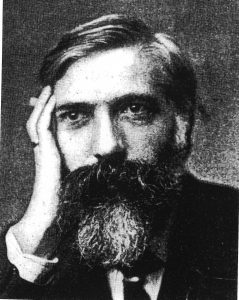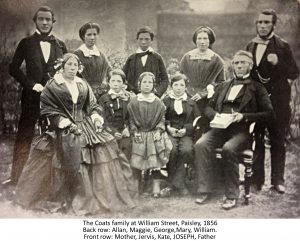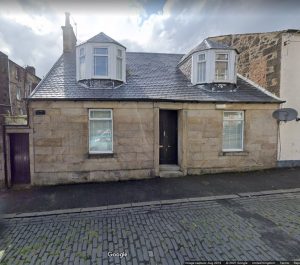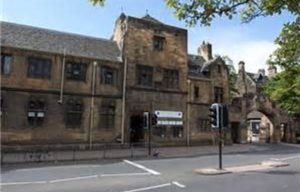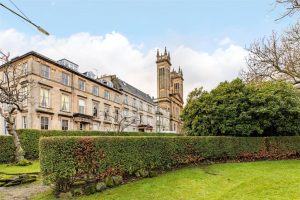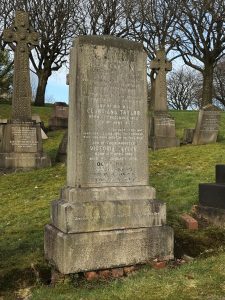Professor Joseph Coats MD Professor of Pathology, University of Glasgow
By Ann O’Connell and Morag T Fyfe
In the afternoon of Friday 27th January 1899 an impressively large funeral took place at Glasgow Necropolis, a public service having been held earlier at the Adelaide Place Baptist Church. The cortege was a very long one, including no fewer than 20 coaches. The large attendance included the Principal and other members of the Senate of the University of Glasgow, and a representative body of the students, the committee of the University Club, along with a number of public citizens.
Who was this man of whom Sir William T Gairdner, a friend and colleague, said in an obituary “His memory will long remain in Glasgow without alloy of bitterness of any kind, for he was a man as gentle as he was religious”.
Joseph Wilson Coats was born in Paisley on 4th January 1846, the youngest of the eight children of William Holmes Coats (1798-1889) and Mary Wilson. He had four older brothers: William (b.1832), Allan (b.1834), George (b.1843) and Jervis (b.1845) and three sisters Janet (b.1829), Margaret (b.1839) and Mary (b.1840). Census records show the family home as being 5 William Street, Paisley.
His family was a branch of the famous Coats family of Paisley that would rise to great prominence and wealth in the thread making business. The several branches of the Coats family in Paisley were involved in hams, thread or in the ministry and Joseph’s father was in business as a ham curer. Father William served on the Town Council and was an active member of the Baptist Church serving as Church Manager and Treasurer at Storie Street Baptist Church. His paternal grandfather was Jervis Coats (1772-1838). His great uncle was James Coats (1774-1857) founder of J&P Coats the thread makers.
There is disagreement in Coats’ obituaries as to where in Paisley he was educated. One obituary stated the John Neilson Institute and another the Grammar School. As the Institute was set up to educate poor orphaned boys it seems much more likely that Coats attended the Grammar School. At the age of 17 he came to Glasgow University (at its old site on High Street), where he studied for two years in the Arts classes, afterwards taking the full medical curriculum and graduating MB in 1867 with first-class honours
University career and interests.
Joseph Coats’ first position after graduating in 1867 was at the Glasgow Royal Infirmary as resident-assistant to Sir William Tennant Gairdner (1824-1907), Regius Professor of the Practice of Medicine at Glasgow University from 1862 to 1900, Medical Officer of Health for Glasgow from 1863 until 1872 and latterly the first Senior Physician of the Western Infirmary. Coats time there also coincided with that of Joseph Lister who was pioneering the use of carbolic acid as a sterilising agent at the time.
After serving his term as resident in the Glasgow Royal Infirmary, Coats went to Leipzig, where, for a year, he engaged in experimental physiology in the laboratory of Professor Ludwig. Subsequently he studied pathological anatomy at Würzburg, under the pathologist Professor von Recklinghausen.
On his return from Germany in 1869 he was appointed pathologist to the Glasgow Royal Infirmary, in succession to Dr. Samuel Johnston Moore, a post which he filled till 1875 during which time he took the degree of MD in 1870. During his tenure of office at the Royal, he worked at morbid anatomy and histology, with unceasing zeal, shown by his report books now preserved in the laboratory. The departmental museum also received his careful attention and, besides adding many specimens to its shelves, he published in 1872 the first printed catalogue of the collection. At the time he was not only the pioneer in pathological teaching, but for many years afterwards was the only teacher of the subject in Glasgow and his lectures were necessarily recognised by the University as qualifying for the degree.
By this time the University had moved to Gilmorehill and the newly built Western Infirmary became the University’s teaching hospital. Coats was appointed pathologist to the Western Infirmary in 1875 where he established the Glasgow School of Pathology.
He had always devoted himself to the work of teaching, and with his appointment to the Western the opportunity came for the full development of his powers in this direction. From 1876 onwards he was an independent teacher. Before that he had lectured merely as one of the assistants to the Professor of the Institutes of Medicine. His class which, till the opening of the new buildings in 1896, met in the Medical Lecture Room of the Western Infirmary, was one of the most popular in the medical curriculum. Coats was not a fluent or expressive speaker, and for the first few years he read his lectures; but after 1878, these were delivered without the aid of notes. In 1877 he commenced the teaching of practical pathology to a class of about four students; and by 1879 there were about a dozen. The accommodation then available for practical teaching was of the most meagre description, but the pathologist made the best of it, and there was no class in those days more thoroughly enjoyed and appreciated than “Coats’ practical”. In addition to his teaching he worked without ceasing at microscopic pathology, and his contributions to the literature on this subject were many and valuable. He showed what could be done on limited means. His workroom for twenty years was a small den, perhaps 12 feet square, with a table at which he and his assistant were wont to work, and frequently also to lunch when the work was particularly heavy during the summer session.
In 1882 he began the writing of his Manual of Pathology, the first edition of which appeared in 1883, and which went into several editions. From the first this book became one of the standard works on pathology in the language, and its publication established the reputation of its author as one of the foremost pathologists of the day. His work upon The Pathology of Phthisis Pulmonalis, published in 1888 in a volume entitled Lectures to Practitioners, in collaboration with Sir W. T. Gairdner, was also authoritative.
Until 1893 there was no Professor of Pathology in the University of Glasgow. The chair was founded by the University Commissioners in that year, and Coats, who for nearly twenty years had been professor in all but name, was unanimously called upon to fill it. There was a general feeling of satisfaction throughout the entire profession when the hard-working, self-denying pathologist received this reward of his labours. For many years the foundation of the chair had been talked of, and Coats must often have been expected to be appointeIn 1896 the Pathology Institute, a building to be jointly occupied by the University and the Western Infirmary, opened. Professor Coats was heavily involved in negotiations. The new building contained a lecture-theatre, a post-mortem room, a museum with accommodation for 5,000 preparations on the shelves, a chemical laboratory, rooms for the pathologist and their assistants, a bacteriological laboratory, two large practical classrooms, rooms for private investigation, a large refrigerator, a mortuary and a chapel. It was designed by J. J. Burnet the Glasgow Architect of choice at that time. Around that time he also designed the McIntyre Building and the residences at University Gardens.
But just when his life’s reward had come the first symptoms of the illness destined to cut short his career became evident, and during the last three years his work was much interfered with by ill health.
As a pathologist, Coats made his mark rather as a morbid anatomist and histologist than as an experimenter. One thing Coats could impress upon his pupils was the close relationship between clinical medicine and pathological anatomy and physiology. His long -association with clinical work caused him to realise this in a sense that the mere laboratory worker could never hope to, and the clinical bearings and importance of his demonstrations were never forgotten – most important, surely, in a school where the great majority of the students were to become general practitioners of medicine. His example of continuous steady work had a most beneficial effect upon his pupils, all of whom regarded him with the respect which his upright and just character inspired; and those who were more closely associated with him in professional work looked upon him as the warmest of friends and the most generous of masters.
In addition to his University work, Coats was an active member of the medical societies of Glasgow, and he filled the offices of president at two of the most important: the Medico-Chirurgical and the Pathological and Clinical Societies. Of the latter, indeed, he was one of the founders. He always took a prominent part in the social life of the University, and in the promotion of the Students’ Union he was one of the most zealous workers. He was also an active member of the British Medical Association, and filled successively the offices of vice-president and president of their section of pathology.
Family life
In 1879 Coats married Georgiana Wilson Taylor (1852-1927) who had historical ties with the Paisley Baptists. She was a cultured intellectual who, together with her husband, played a large part in the life of the community of Adelaide Place Baptist church. Coats himself held the offices of President of the Baptist Theological College of Scotland and Deacon of Adelaide Place Church, Glasgow.
Prior to his marriage Coats had lived in Bath Street and Elmbank Street and their first married home was just round the corner at 7 Elmbank Crescent. All these addresses were close to Adelaide Place church which was only a few blocks away along Bath Street at the corner of Pitt Street. However the 1881 census on 3rd April found the couple, along with two of Mrs Coats’ younger sisters at Gowanbank, on the West Bay, Dunoon, Argyll. This may have been an early Easter break at a favourite haunt as it is known that Joseph, his parents and family had been in the habit of spending five months each summer at Willowbank, Dunoon.
By 1891 Mr and Mrs Coats are found living in Lynedoch Street, Glasgow with their two daughters Olive (1882-1975) and Victoria (1885-1940) and three servants. When Coats became Professor of Pathology at Glasgow University in 1893 they were the first residents at 8 University Gardens part of a new terrace designed by John James Burnet. Georgiana Coats survived her husband’s death by many years finally dying in 1927 while on holiday in Pitlochry. She had continued to live at 8 University Gardens for a number of years before moving to Queensborough Gardens. In 1929 Olive and Victoria published Dr. and Mrs. Joseph Coats: A Book of Remembrance compiled by Their Daughters in memory of their parents. Coats personal papers passed to the care of the University of Glasgow after the death of Olive Coats, his remaining daughter, in 1975.
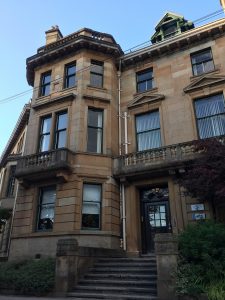
8 University Gardens, Glasgow
By Lirazelf – Own work, CC BY-SA 4.0, https://commons.wikimedia.org/w/index.php?curid=72368126
His religious life and the Baptist Church
He was a deeply religious man, although in many things – such as Sabbatarianism – tolerant to a degree, seldom found in Scotland in the 1850s in any Protestant denomination. The Storie Street Baptist Church, of which he was a member, before he moved to Glasgow, had always been noted for its liberalism. Thus it was that young Coats – who dare not miss going to church twice on Sunday – could, after church hours, walk in the country, or even read a novel, as he often did, without any sign of parental disapproval. With such heredity, and such surroundings, it is no wonder he grew up a grave, thoughtful, simple man, righteous in all his ways, and caring much more to do justly than to earn the applause of men.
His final illness
The malady from which Professor Coats suffered, and which finally caused his death, was a malignant tumour of the splenic flexure of the colon. For a lengthened period the symptoms were of an obscure and puzzling character. They first appeared about 1896, and took the form of repeated feverish attacks, closely resembling those of malaria. Indeed, he himself at first thought that the disease might be malaria, which, he thought, he might possibly have contracted during a visit to Rome. After about two years a tumour was discovered in the left side of the abdomen, whose nature, however, long remained obscure. During a voyage to Australia the feverish attacks recurred several times, and in Egypt, on his way home, he suffered very severely from an attack of dysentery. During the later months of 1898, after he had suffered from one or two attacks of intestinal obstruction, the true nature of his disease became apparent. From this time he rapidly sank, and, in spite of all that medicine and surgery could do, he succumbed on the morning of 24th January, 1899.
The man and his legacy
Professor Coats was a much admired teacher but was known to have a coldness of demeanour and habit of scrutinising his students which instilled a bit of fear. But behind all this there was a kindness of heart, a single-mindedness of purpose, an innate inflexible sense of justice, and a passionate love for his work and his profession which united his intimates to him in the bonds of affection. The welfare and prosperity of his students were ever close to his heart, and if he was less given than most to the expression of his emotions, they were none the less real and sincere.”
At his funeral service The Very Reverend Principal Robert Story declared that:
“None could know him without feeling that he was one whose heart was clean, whose ways were gentle, whose affections were tender, whose aims were high. … He has left a lofty example and a worthy name of which his University is proud, a memory which we shall always cherish with affectionate regret, work achieved that will long bear wholesome fruit, though he himself has not lived to see it gathered.”
Sources
This biography is based primarily on the obituary of Joseph Coats written by his old friend and colleague Sir William T Gairdner and published in the British Medical Journal 4th February 1899, pp 317-319. The anonymous obituary in the Glasgow Medical Journal vol 51 January – June 1899, pp 108- 118 also proved most helpful. A third source was the second part of an article entitled The Coats family and Paisley Baptists published in the Baptist Quarterly vol 36, parts 1 & 2 (1995-6). Coats’ death and funeral were widely reported in many newspapers including, of course, the Glasgow Herald. References to him can be found on several parts of the University of Glasgow website (https://universitystory.gla.ac.uk/).










